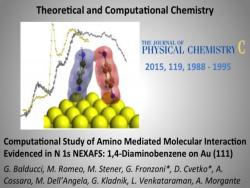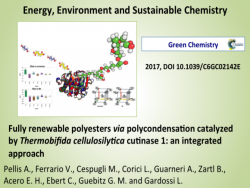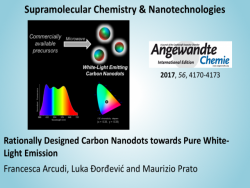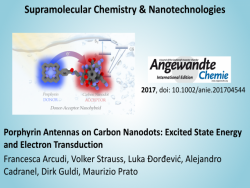Development of metal complexes for photocatalysis and supramolecular assemblies
The aim of this research line is that of developing novel metal complexes – in particular of Ru(II) and Re(I) – to be used as precursors in the synthesis of metal-porphyrin conjugates and in the construction of supramolecular assemblies for photocatalysis and molecular recognition. The figure below reports the schematic structure of a generic metal conjugate.

The organic photosensitizers needs to be connected to the metal fragment through a bifunctional chelating agent, a linker, i.e. a molecule with two functional groups – that typically point in opposite directions: one funtional group (e.g. a -COOH) must be capable of making an organic bond with the photosensitizer (e.g. an amidic or esteric bond), the other must be suited for binding the metal fragment. Since the metal coordination sphere has to be stable in both kinetic and thermodynamic terms, chelating fragments are often used for this purpose.
Therefore, in the ideal metal precursor the number and geometry of the binding sites (i.e. relatively labile leaving ligands, such as dmso, CH3CN or Cl–) has to match exactly the binding preferences of the linker connected (or to be connected) to the photosensitizer. The other ancillary ligands on the metal are inert, most often chelates, in order to afford thermodynamic and kinetic stability. In addition, ligands are selected with the aim of keeping the geometry of the metal fragment as symmetrical as possible, in order to limit the formation of stereoisomeric products upon binding of the linker. Finally, since solubility of the final adducts in aqueous solution is a primary goal, at least one coordination position will be occupied by highly hydrophilic ancillary ligands such as 1,3,5-triaza-7-phosphadamantane (pta).
Recently we investigated the coordination of the bidentate linker 2-(2'-pyridyl)pyrimidine-4-carboxylic acid (cppH) to a Ru(II) precursor. The results have been reported as a communication on Dalton Transactions: "An irresolute linker: separation, and structural and spectroscopic characterization of the two linkage isomers of a Ru(II)-(2-(2'-pyridyl)pyrimidine-4-carboxylic acid) complex." (Dalton Trans. 2014, 43, 12160-12163. DOI: 10.1039/C4DT01282H.)
Pertinent publications from year 2009
1) E. Zangrando, N. Kulisic, F. Ravalico, I. Bratsos, S. Jedner, M. Casanova, E. Alessio*
New ruthenium(II) precursors with the tetradentate sulfur macrocycles tetrathiacyclododecane ([12]aneS4) and tetrathiacyclohexadecane ([16]aneS4) for the construction of metal-mediated supramolecular assemblies.
Inorg. Chim. Acta, 2009, 362, 820-832.
2) I. Bratsos, E. Alessio
Ruthenium(II)-chlorido complexes of dimethylsulfoxide
Inorg. Synth., 2010, 35, 148-152 (doi: 10.1002/9780470651568.ch8).
3) E. Iengo,* T. Gatti, E. Zangrando, M. T. Indelli, F. Scandola, E. Alessio*
Concerted motions in supramolecular systems: metal-mediated assemblies of porphyrins that behave like nanometric step-machines.
Chem. Commun. 2011, 47, 1616-1618 (DOI: 10.1039/c0cc03513k)
4) E. Alessio, M. Casanova, E. Zangrando, E. Iengo*
Modular self-assembled multiporphyrin cages with tunable shape.
Chem. Commun.2012, 48, 5012-5015.
5) I. Finazzi, I. Bratsos, T. Gianferrara, A. Bergamo, N. Demitri, G. Balducci, E. Alessio*
Photolabile RuII Half-Sandwich Complexes Suitable for Developing “Caged†Compounds: Chemical Investigation and Unexpected Dinuclear Species with Bridging Diamine Ligands.
Eur. J. Inorg. Chem. 2013, 4743–4753. DOI:10.1002/ejic.201300792
6) I. Bratsos, S. Calmo, E. Zangrando, G. Balducci, E. Alessio*
New cationic and neutral Ru(II)- and Os(II)-dmso carbonyl compounds.
Inorg. Chem. 2013, 52, 12120–12130. DOI: 10.1021/ic401940z
7) E. Iengo, N. Demitri, G. Balducci, E. Alessio*
An irresolute linker: separation, and structural and spectroscopic characterization of the two linkage isomers of a Ru(II)-(2-(2′-pyridyl)pyrimidine-4-carboxylic acid) complex.
Dalton Trans. 2014, 43, 12160-12163. DOI: 10.1039/C4DT01282H.
Research Group
| Prof. Alessio's Group |







